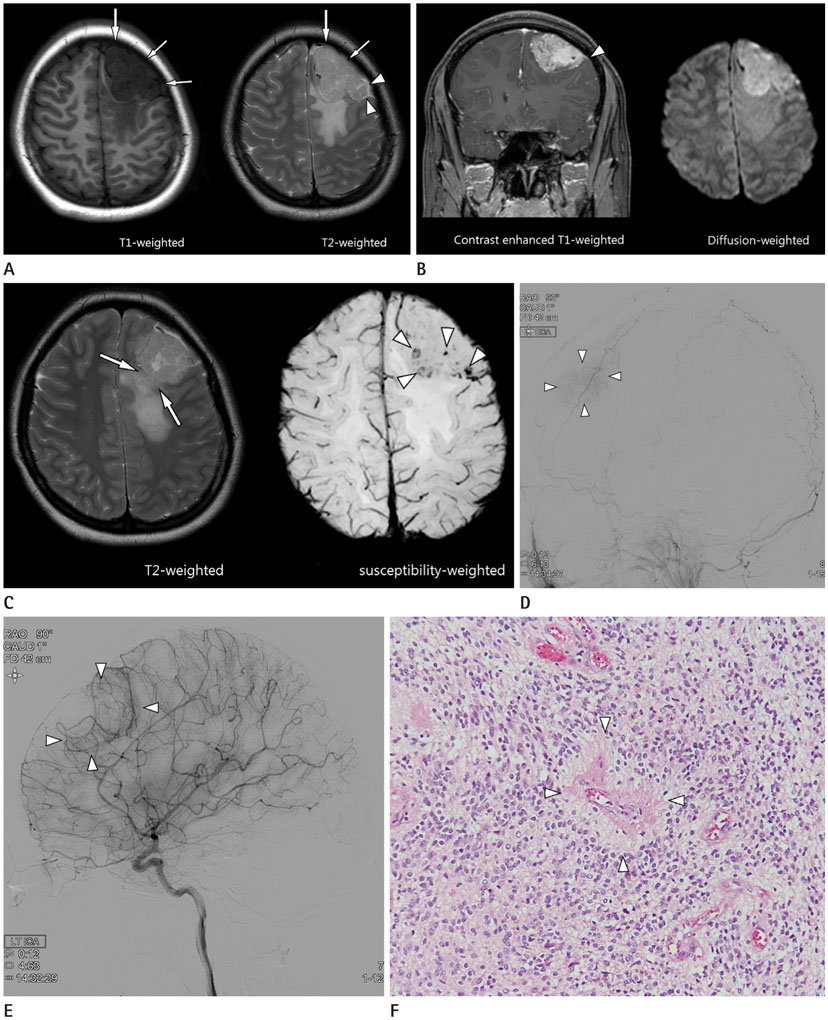J Korean Soc Radiol.
2017 Oct;77(4):254-257. 10.3348/jksr.2017.77.4.254.
Supratentorial Anaplastic Ependymoma Mimicking an Extra-Axial Tumor: A Case Report
- Affiliations
-
- 1Department of Radiology, Jeju National University Hospital, Jeju National University School of Medicine, Jeju, Korea. hoklee33@gmail.com
- 2Department of Pathology, Jeju National University Hospital, Jeju National University School of Medicine, Jeju, Korea.
- 3Department of Neurosurgery, Jeju National University Hospital, Jeju National University School of Medicine, Jeju, Korea.
- KMID: 2392124
- DOI: http://doi.org/10.3348/jksr.2017.77.4.254
Abstract
- Ependymoma is a glioma which arises from the ependymal cells lining the ventricle and the central spinal canal. It commonly occurs in the brain outside the ventricle in the supratentorium, in case of a supratentorial ependymoma. We report a case of supratentorial exophytic anaplastic ependymoma mimicking an extra-axial tumor.
Figure
Reference
-
1. Davis MJ, Hasan F, Weinreb I, Wallace MC, Kiehl TR. Extraventricular anaplastic ependymoma with metastasis to scalp and neck. J Neurooncol. 2011; 104:599–604.2. Elsharkawy AE, Abuamona R, Bergmann M, Salem S, Gafumbegete E, Röttger E. Cortical anaplastic ependymoma with significant desmoplasia: a case report and literature review. Case Rep Oncol Med. 2013; 2013:354873.3. Singh V, Turel MK, Chacko G, Joseph V, Rajshekhar V. Supratentorial extra-axial anaplastic ependymoma mimicking a meningioma. Neurol India. 2012; 60:111–113.4. Leng X, Tan X, Zhang C, Lin H, Qiu S. Magnetic resonance imaging findings of extraventricular anaplastic ependymoma: a report of 11 cases. Oncol Lett. 2016; 12:2048–2054.5. Shuangshoti S, Rushing EJ, Mena H, Olsen C, Sandberg GD. Supratentorial extraventricular ependymal neoplasms: a clinicopathologic study of 32 patients. Cancer. 2005; 103:2598–2605.6. Vernet O, Farmer JP, Meagher-Villemure K, Montes JL. Supratentorial ectopic ependymoma. Can J Neurol Sci. 1995; 22:316–319.7. Mangalore S, Aryan S, Prasad C, Santosh V. Imaging characteristics of supratentorial ependymomas: study on a large single institutional cohort with histopathological correlation. Asian J Neurosurg. 2015; 10:276–281.8. Han MH, Park KS, Park SH, Hwang JH. Supratentorial extraventricular anaplastic ependymoma presenting with repeated intratumoral hemorrhage. Brain Tumor Res Treat. 2014; 2:81–86.9. Osborn AG. Osborn's brain: imaging, pathology and anatomy. 1st ed. Philadelphia: Lippincott Williams & Wilkins;2013. p. 585–595. .10. Sotoudeh H, Yazdi HR. A review on dural tail sign. World J Radiol. 2010; 2:188–192.
- Full Text Links
- Actions
-
Cited
- CITED
-
- Close
- Share
- Similar articles
-
- A Case of Supratentorial Intra-axial Ependymoma Showing Exophytic Growth
- Supratentorial Extraventricular Anaplastic Ependymoma Presenting with Repeated Intratumoral Hemorrhage
- A Case of Recurrent Supratentorial Extraventricular Anaplastic Ependymoma in Adult
- Gangliocytoma Mimicking Extra-axial Tumor: A Report of Two Cases
- Supratentorial Cortical Ependymoma in a 21-Month-Old Boy


